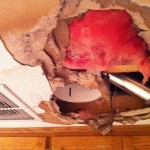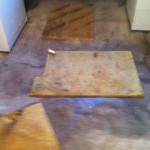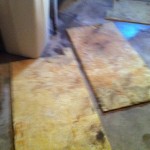Water Damage From Frozen & Broken Pipes
Frozen and broken water pipes are not thought of as a catastrophe or anywhere near the same scale as a natural disaster, but damage from water is the most prevalent, yet least recognized catastrophe. In fact, frozen and broken water pipes rank No. 2 only behind hurricanes in terms of both the number of homes damaged and the amount of insurance claim costs in the U.S. In most cases, pipes break during freezing weather.
As temperatures fall, water expands and causes localized pressure. When the pressure becomes too great, a break occurs. This may create a pinhole leak, hairline break or large crack.
Damage from frozen and broken water pipes can be a homeowner’s nightmare. When a pipe bursts, water gushes from the pipe like a fire hydrant, turning a basement into a lake within just a few minutes. Water from frozen and broken pipes causes the most damage while people are away from home or while they’re on vacation and their home is vacant. The plumbing can rupture and water can run unnoticed for several days. Repairs of around $50,000 are common due to water’s fury.
Here is an example of a home in Brooklyn Park Minnesota. The home was vacant and the Pergo floors were water damaged.
- Furnace went out and fridge water filter broke and caused flooding
- Removed the laminate floor and dried it out
- Structure was completely disinfected
Frozen and Broken Water Pipes are Preventable
Frozen and broken water pipes are a significant cause of loss across the nation. Damage can include soaked and water damaged drywall. Wallpaper turns moldy. Kitchen cabinets warp, and carpets, floors and draperies can be ruined. Photo albums, paperwork, antiques, furniture and clothing also can be destroyed. Sometimes homes actually have to be totally gutted because mold and mildew cover every inch from floor to ceiling.
Unlike hurricanes, frozen and broken water pipes are preventable. Efforts to prevent pipes from breaking in your home will save you from the nightmares of a water damage emergency and help reduce the enormous insurance claims that result. Policyholders share the financial burden of frozen and broken water pipes through increased homeowners insurance rates.
Research suggests that leaky pipes and general water damage from showers is costing homeowners even more than theft or damage caused by criminals.
According to the research, water damage related insurance claims cost the industry $730 million last year. This is nearly double the cost of claims for theft and burglary last year.
According to the Association of British Insurers (ABI), break-ins and theft damage cost just $370 million in comparison.
The report found that more than 370,000 people made a water leak claim last year, with the average claim just under $2,000. The average burglary claim was $1,400 last year. Obviously, preventing broken water pipes is in your best interest
Tips To Prevent Frozen and Broken Pipes
According to the Insurance Information Network, there are five easy things you can do to protect your home from frozen and broken water pipes:
1. Disconnect all garden hoses and other outside hose connections. If possible, use an indoor valve to shut off and drain water from pipes leading to outside faucets.
2. Insulate all exposed pipes located in your basement, under your home, on outside walls or in attics. For pipes with northern exposures, use heat tape according to the manufacturer’s instructions. (Improper usage may cause a fire.)
3. Set the thermostat to at least 55 degrees even when your home is vacant or unoccupied during the winter. If you plan to be away during cold-weather months, have someone regularly check your home to make sure it’s staying warm enough to prevent freezing.
4. Winterize sprinkler systems according to the manufacturer’s recommendations. Blowing out excess water with a compressor may be the best way to prevent frozen and broken pipes. If you have a swamp cooler, winterize it by disconnecting the water source and clearing the line.
5. Very important is knowing how to shut off the water supply if a pipe bursts. Quick action can minimize damage.
Taking these few precautions before the next freeze sets in may save your home from the devastating effects of frozen and broken water pipes.
Disasters Don’t Wait For Normal Business Hours
If you’ve never had frozen or broken water pipes, consider yourself lucky. If you are not one of the fortunate ones, contacting a professional restoration company is your best bet to keep damages to a minimum. A professional water damage restoration contractor will select the structural drying equipment in a scientific method based on materials, size of the water damage area, and the class and category of the water damage.
Any drying must be done right to prevent further damage. That’s why you need a Certified Minnesota water damage expert that is available 24 Hours a Day / Seven Days a Week / 365 Days a Year that can and will dispatch a crew to your home within the hour to do an evaluation!!!!
He or she will be qualified through formal training and experience to remove excess water efficiently, to promote efficient evaporation and to establish the dehumidification conditions necessary to stop on-going damage.
A message for Snowbirds from the Insurance Federation of Minnesota: Don’t Let Your Winter Escape Cost You More Money






